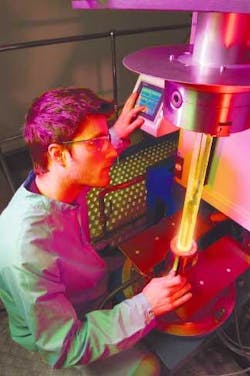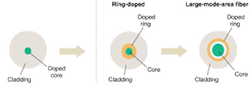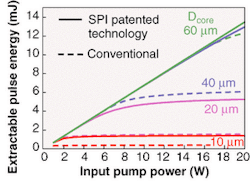The rapid advances being made in the development of fiber lasers are leading to fiber-laser specifications that closely match those of traditional lasers. As a result, the next 18 months could see fiber lasers being deployed onto the manufacturing floor. Several innovations are enabling this transition, including increased laser-diode brightness and reliability, improved laser diode-to-fiber coupling, and advances in specialty fiber for the active medium. In addition, because of development progress made during the telecom boom, components for fiber lasers have become more cost-effective even while exhibiting the high reliability levels required for telecom applications.
There are five basic ingredients of a fiber laser and with one exception (pump coupling), these are the same components required for traditional laser systems: pump sources (laser diodes), pump coupling (coupling of laser diodes to active medium), a gain medium (active fiber), mirrors (fiber Bragg gratings), and cooling (usually air cooling).
The first of these ingredients, laser diodes, has shown major improvements as a direct result of the telecom boom. Single-mode 980-nm pump lasers have been deployed in undersea, high-reliability applications with 25-year lifetimes, while traditional broad-area high-power devices were proven to only 10,000 hours. Recently, the application to high-power devices of the process and design techniques originally established for single-mode lasers has moved reliability estimates toward 50,000 hours and beyond. Fiber-coupled single-emitter high-power diode lasers have evolved from limited output powers (1 to 2 W from the fiber) to providing high-brightness fiber-laser building blocks of 5 W from the fiber. These building blocks can be combined, resulting in pump units that can deliver more than 30 W (see Fig. 1).
An interesting crossover technology is the combination of laser-diode bars, beam-shaping optics, and telecom-style packaging. Although this arrangement has the potential for even greater brightness than high-power single-emitter solutions, much work remains to be done in this promising area.
There has been a lot of debate about the reliability of laser-diode bars and their contribution to the total lifetime cost of traditional diode-pumped solid-state (DPSS) lasers and this will certainly continue, but the clear advantage for laser diodes used with fiber lasers is that all the elements that contribute to laser-diode failure can be minimized from the design start. Packages can be sealed from the environment, for example; single-emitters and nonstacked diode bars can more easily be thermally controlled; and—helped by the telecom downturn—low dollar-per-watt pricing is allowing redundancy to be added. As a result, total operational lifetime costs of fiber lasers over five years are about one-third those of DPSS lasers, with similar capital-expenditure pricing for equal performance.
Specialty fiber
While independent of solid-state laser pump diodes, fiber-laser performance and future use is almost entirely dependent on novel approaches to specialty fiber manufacturing for both the active medium and for fiber coupling. Rapid progress is being made. Even the most basic element, the fiber Bragg grating, contributes to the overall stability and reliability of the fiber laser through enhancements that allow these gratings to be written directly in the active medium. The simplest fiber lasers are based on technology similar to that used in telecom fiber amplifiers—active core-doped fibers. The gain medium is a fiber core doped with ytterbium, erbium, or ytterbium and erbium, which is then pumped. There are two choices for the pump configuration: either core pumping or cladding pumping.
Cladding pumping is preferred for high-power devices because it allows lower-cost multimode diode pump lasers to be used while still achieving very high pump-absorption efficiencies (greater than 50%). Cladding pumping can be executed from the end or side. One example of side pumping at SPI is based on a specially developed fiber in which two pump fibers are wrapped around the active fiber and then manufactured by drawing like any other fiber. The coating of the fiber can be removed easily; pump fibers can be unwrapped and then spliced onto pump laser diodes or to units of laser diodes, thereby accelerating the manufacturing process. This arrangement allows for scalability as well as ease of manufacturing. Since there are two pump fibers, up to four laser diodes can be used at one time with the same fiber.
Active fibers can also be spliced together allowing for consecutive or cascaded pump stages. Because additional pump fibers can be drawn together with the active fiber to allow even more power coupling in this staged concept, two pump fibers or stages are not the limit of this technology. In addition, if photosensitive material is added to the active medium, the fiber grating can be written in the core, thereby creating a fiber laser that is homogeneous from point of lasing to point of use.
Given the small mode area and core doping, all fiber lasers quickly run out of output power and pulse performance compared to DPSS lasers unless the active fiber is again modified for better power handling. For continuous-wave (CW) powers, some fiber-laser options have been investigated and commercialized in which multiple active fibers are bundled together. This scales the continuous-wave power very quickly and well into the kilowatt regime, but forces the M2 value to rise quickly, peaking in the range of 22.
To date, pulsed fiber lasers are limited to peak output of about 3 to 5 kW, or pulse widths of around 200 ns at a repetition rate of 20 kHz, up to 40-ns pulse width at a repetition rate of 100 kHz. These specifications greatly limit the number of applications and give DPSS devices a performance advantage. The limits are primarily due to gain-medium self-saturation, the damage thresholds of such fiber designs, and nonlinear limits.
Redesigning the traditional active fiber in fiber lasers, therefore, is a prerequisite for competitive performance vs. DPSS devices. We have developed two active-fiber design options for commercial products (see Fig. 2). The first increases the gain saturation limit: ring-doped fibers move the active medium out of the center of the fiber—but still within the reach of the pulse transmission—and allow much higher energies to be stored within the fiber and then released as a Q-switched pulse in the multiple milliJoule regime. For the second option, an increased mode area overcomes the other two fiber-laser limits: fiber damage and nonlinearities. Increasing the area that carries the energy within the fiber allows the fiber to handle much higher powers (see Fig. 3).
Nonlinearities are also reduced by the increase in area. Initially these fibers will provide a peak power-handling capacity in the range of 25 kW or about a pulse width of 40 ns with a repetition rate of 10 kHz. These same fibers are expected eventually to achieve about 50 kW or about a pulse width of 20 ns with a repetition rate of 10 kHz, which is within the competitive space of marking applications of traditional solid-state lasers.
Finally, the ability of pulsed fiber lasers to resist feedback may also prove to be a major advantage because the pulsed products can be manufactured with isolators to limit reflections from the downstream system.
Improving M2
Addressing the M2 at very high powers with fiber lasers involves a redesign of the basic fiber-laser architecture. It is very likely that kilowatt-level output can be reached with M2 < 2 by marrying the right architecture such as a traditional MOPA (master oscillating power amplifier) using a distributed-feedback (DFB) fiber-laser-based seed source with correctly modified specialty-fiber designs. The MOPA architecture has been used for years with traditional lasers. Starting with a very narrow and low-noise source such as a fiber DFB, the seed source is consecutively amplified until kilowatt-level single mode powers are achieved with minor performance deterioration.
For high CW power with narrow linewidth we have developed a distributed-feedback (DFB) fiber laser that provides linewidths of less than 30 kHz with RIN of less than –150 dB/Hz. Again these devices are based on active fibers with complex laser cavities written into the waveguide containing an active medium, which are then end-pumped. A particularly attractive application is a DFB fiber laser operating at 976 nm and frequency-doubled to 488 nm. It offers a solid-state replacement for argon ion lasers currently used in research and analytical instrumentation. Diode-pumped solid-state technology cannot address this important wavelength. Our technology roadmap for these products includes powers up to 1 W, which can then be amplified to 10 W or higher.
Even more exciting, and helped by such rapidly advancing technologies as SESAMs (semiconductor saturable absorber mirrors) and PPLN (periodically poled lithium niobate), fiber lasers have the potential of not being limited to one particular application arena, but to providing a completely passive and all-fiber (fiber from the point of laser-diode coupling through the active medium to the point of use) alternative for large majority of applications from ultrafast multiphoton analysis to frequency-doubled semiconductor processing applications. Helped by the telecom boom and recent specialty-fiber innovations, fiber lasers now have the momentum to take on DPSS technology in the same way and for the same reasons that DPSS lasers were able to reshape the laser industry a few years ago.
STUART WOODS is business development director at SPI (Southampton Photonics), Phi House, Enterprise Rd., Chilworth Science Park, Southampton S016 7NS, England; e-mail: [email protected] .


